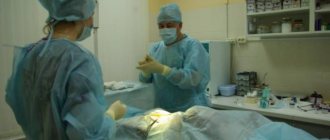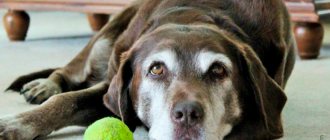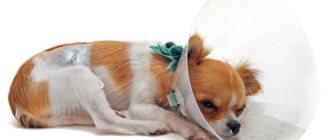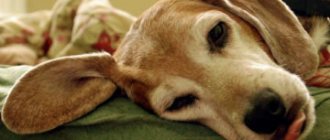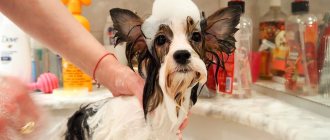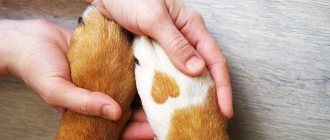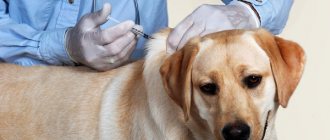Waking up after anesthesia
After the operation, the doctor conducts a consultation for the dog's owner. He talks in detail about the features of the rehabilitation period. It is important to write down what to feed your pet during recovery and how to change its future diet, what medications relieve pain, and what symptoms require immediate hospitalization.
After castration, a dog is discharged even before waking up from anesthesia. Therefore, during the trip home, cover her with a warm blanket. Anesthesia slows down all processes in the animal’s body and lowers body temperature. Upon awakening, a frozen pet will feel muscle pain. Small breed dogs (Yorkies, Spitz, Chihuahuas) are especially sensitive to cold.
At home, prepare a place for your pet to rest. It should be located away from the battery, passage, or open window. Place a moisture-absorbing diaper on the bedding and cover the animal with a blanket.
If the dog has not yet awakened, observe its condition. Normally, the pulse is slightly slow, and breathing is even and monotonous.
Alarming symptoms that should prompt you to call a veterinarian:
- awakening does not occur 6 hours after surgery;
- increased body temperature, convulsions;
- blue tint of mucous tissues;
- intermittent breathing with wheezing;
- vomiting with blood.
Take the day off to care for your dog after sterilization. When waking up from anesthesia, the pet is disoriented. He trembles, tries to get up, staggers, and vomits mucus. Help him come to his senses, calm him down with the sound of your voice and stroking him. Give him something to drink or wet his mouth with water from a syringe without a needle.
Drug support
Caring for a dog after castration surgery includes medicinal support. After surgery, antibiotics are required to prevent inflammation. Ceftriaxone or Sinulox is administered intramuscularly to dogs. To do this, the product is diluted with a solution of 0.5% novocaine. The dosage is calculated individually. The course of treatment is 5-7 days.
To reduce the intensity of pain, veterinarians prescribe:
- Analgin;
- Tolfedine;
- Ketanov;
- Traumatin;
- Rimadyl.
Seam processing is carried out using:
- Chlorhexidine;
- Alumistrea;
- Levomekol.
To strengthen the immune system, the following is prescribed:
- Gamavit;
- Vitam.
Dry mucous membranes of the eyes are moistened with the drug Artificial tear.
After sterilization - caring for the dog
First day
The most difficult and dangerous in terms of complications are the first postoperative days. The dog is still under the influence of drugs that can cause hallucinations, nausea, and vomiting.
The operated dog needs vigilant supervision.
As she emerges from the semi-conscious state in which she was after sterilization, she begins to feel severe pain. For these reasons, the animal must be under the supervision of the owner throughout the postoperative period , so that if bleeding or severe vomiting begins, the person can help his pet.
- The veterinary surgeon must give recommendations for caring for the dog, set the time for the next visit and outline the necessary treatment. Immediately after arriving home, the animal must be placed on moderately soft bedding and not allowed to rush or jump up. You should not give the dog water or food in the first twelve hours, but if the dog is very thirsty, you can give it half a glass of water every two hours.
- If your pet is feeling nauseous or vomiting, you should not give it water. Nausea most often begins as a consequence of the action of drugs for anesthesia; this condition will go away on its own after some time. Persistent vomiting repeated repeatedly is a sign of severe intoxication; medical consultation may be required.
- Immediately after the operation, the veterinarian seals the suture with a special adhesive plaster, and on the first day it does not require additional treatment. Care should be taken to ensure that the dog does not try to tear off the adhesive plaster; to do this, they put on a special blanket with ties on the back. Thick cotton fabric covers the postoperative suture and prevents licking and gnawing of the suture.
- After returning from the clinic, the dog can be taken for a walk to recover. It is necessary to go down and up the stairs very carefully, avoid jerking; it is better to carry small pets in your arms.
Seam processing
In the postoperative period after castration of the dog, the owner needs to take care of the suture. It is located in the lower abdomen and extends from the navel to the tail. Normally, veterinarians remove the threads at 10-14 days. But if the suture material heals quickly or is rejected, this procedure is performed earlier.
As the wound heals, the suture begins to swell and itch. Therefore, its treatment does not cause any unpleasant sensations to the dog. On the contrary, softening the crusts with ammonia eliminates itching and a feeling of tightness of the skin.
After general hygiene, treat the wound with Levomekol or Chlorhexidine ointment, apply a gauze bandage, and secure it with an adhesive plaster. A special blanket and bandage will protect the seam from dirt, dog teeth and claws.
Diet changes
Early rehabilitation of a dog after spaying or neutering includes a fasting diet for 24 hours. At the same time, the pet must have access to clean water. After anesthesia, the dog's swallowing reflex is weakened. Food can enter the bronchi, blocking access to oxygen, leading to death.
The next day the dog can receive food in liquid and ground form. Give your pet food diluted with water or fermented milk drinks, vegetable puree, poultry broth. Vegetable oil dressing and herbal decoctions (senna leaves, buckthorn bark, horse sorrel) will enhance peristalsis and relieve constipation. If your dog begins to vomit, extend the fasting diet for another 12 hours.
A dog's diet should change after spaying or neutering. Having lost the excitement of sexual hunting, animals find joy in frequent meals. Their behavior changes after the operation: pets become good-natured, non-aggressive, and lazy. They gain weight easily and have great difficulty losing weight. To prevent obesity, it is necessary to reduce the total calorie content of meals or switch to food for sterilized dogs.
Caring for your dog after sterilization
The operation of spaying or castrating a dog is quite complex, during which the animal is under anesthesia. Most often, the veterinarian removes the entire reproductive organs of a female or male dog. Moreover, if for a female individual sterilization is a full-fledged abdominal operation, then in a male dog only the testes are removed. The duration of the surgical procedure depends on the method chosen by the doctor, as well as on the individual characteristics of the dog. On average, the operation time varies from half an hour to an hour, after which the animal can go home.
General care in the first week after surgery
On the first day after surgery, the dog needs maximum care. After recovering from anesthesia, she was disoriented and did not have the strength to walk to the litter box. Single vomiting and uncontrolled urination are allowed. If your pet whines in pain, you can give him an analgesic tablet.
On the second day the dog’s health improves. She can receive food in the form of liquid or puree.
Breakfast is ¼ part of the usual portion, dinner ½ part. The pet easily navigates the apartment, reaches the litter box, and climbs onto the bed or chair. His temperature returns to normal.
On the third day, the dog again becomes inquisitive and active. His appetite improves and urinary incontinence disappears. On this day, postoperative swelling in the suture area usually disappears. The dog wants to go outside, but is not allowed to walk for long periods of time.
On the fourth or fifth day, the dog’s health stabilizes. She can be left alone in the apartment, allowed to run around the yard (but not up and down the stairs). Bowel movements occur regularly - once a day. The pet can be switched to food for sterilized animals.
On the sixth or seventh day, the dog stops paying attention to the bandages. The scarring process is clearly visible in the suture area. New fur begins to grow. Active dogs (beagles, terriers) cannot yet remove the bandage, as their excessive activity can lead to injuries and complications.
After castration - caring for a male dog
Castration of a male dog is most often performed according to medical recommendations, since this operation greatly changes the dog’s hormonal levels . If there are certain medical indications for castration, the male dog will have his testes removed. The operation takes about half an hour, is performed under general anesthesia, after which a suture is applied. A bandage is usually not done.
First day
The most dangerous thing in the castration procedure for a male dog is how well he tolerates anesthesia, since the removal of the testes is not accompanied by heavy bleeding. The dog stays in the clinic until it comes to its senses after anesthesia, then the owner can take it home.
Preventing the seam from licking.
- At home, it is important to provide the animal with peace; after a couple of hours, you should offer the dog a drink. If he doesn’t want to, he feels sick or vomits, then you need to force him to drink, a spoonful of water or Regidron solution every half hour. Over time, the effects of the drugs used for anesthesia will wear off, and the dog will feel normal again.
- In the first few days, postoperative swelling forms in the scrotum area, which interferes with the dog, and he tries to lick or chew this place. To prevent this behavior, wear a special collar made of plastic or cardboard, which prevents the dog from reaching the back of the body. Bandaging the scrotal area is not recommended, as this limits the normal aeration of the suture and can lead to damage and suppuration.
- In order for the pet to recover, it is taken to the toilet when the effect of the anesthesia wears off. To help your dog recover faster, you can give him weak black tea with lemon. This remedy helps with nausea, increases diuresis, and removes drug residues from the body.
A week after the manipulation, the male feels quite well, the suture usually heals quickly, and after a few months the void in the scrotum is filled with fatty tissue. In modern clinics, at the request of the owners, male dogs can be given implants that completely imitate healthy testes.
Possible complications
After castration, bitches stop going into estrus. Owners no longer need to agree on mating, monitor gestation, childbirth, and lactation. The dog can no longer suffer from false pregnancy and its consequences - mastopathy, pyometra, endometritis. The risk of perineal hernia and cancer with complex surgical treatment (mastectomy, hysterectomy) is reduced. But the spay and neuter procedure can also lead to dangerous complications.
Intra-abdominal bleeding
It may open during the operation or on the first day after its completion. In this case, the main cause of the pathology is a doctor’s mistake. If bleeding appears within a week, then its cause is an injury resulting from excessive activity of the dog.
When internal bleeding occurs, the pet becomes lethargic, its mucous tissues acquire a blue tint, and drops of blood leak from the surgical incision and genitals. Treatment consists of a repeat operation, during which the damaged blood vessel is sutured.
Wound rotting
The reason is infection in the surgical incision. It can be brought in by a doctor (if the clinic does not maintain sterility conditions) or the owner while caring for the suture. Inflammation is manifested by an increase in temperature, the appearance of a putrid odor and smudges under the threads. The wound may diverge, swell, and become covered with hematomas.
To prevent such a pathological condition, a course of antibiotics is prescribed after surgery. The owner must carefully consider the choice of clinic and strictly follow all instructions on caring for the suture in the postoperative period after sterilization of the dog.
Urinary incontinence
5-10% of dogs develop urinary incontinence after castration. You can distinguish the disease from simple disobedience by wet bedding, the absence of signs of guilt, and frequent licking of the genitals. The cause of the disease is a change in hormonal levels. Therefore, the disease does not appear immediately (after 12-20 months) and constantly progresses.
For treatment, the veterinarian prescribes a medicine that strengthens smooth muscle tone. Dogs take it for the rest of their lives.
If the sphincter continues to leak, surgery is prescribed. During this procedure, the bladder neck is moved inside the peritoneum for better control of the valve.
Reviews
Vladimir, Voronezh
“I helped my mother organize the castration of her Shar Pei. The operation did not last long, the dog quickly recovered. The only difficulty was caring for the seam due to Jeanette's thick skin. But we also dealt with this problem.”
Julia, Lipetsk
“I have a shepherd, Lisa. During her heat, it was difficult for me to keep her on a leash. One day she broke away, ran away and almost got hit by a car. After that we castrated her. Now I can calmly take Lisa for walks.”
Expert opinion
To summarize, I would like to say my medical and human opinion. Subjective, based on experience.
If an ordinary domestic dog that leads an active lifestyle does not have health-related indications, the issue of castration should be resolved as necessary, as planned. These issues should be resolved by a loving owner and a thoughtful, caring doctor.
The main thing is an individual approach. The issue of castration must be approached extremely consciously. Weigh the pros and cons, take into account the characteristics of the breed, your dog’s lifestyle, individual health problems and the feasibility of surgery.
Your veterinarian Natalia
